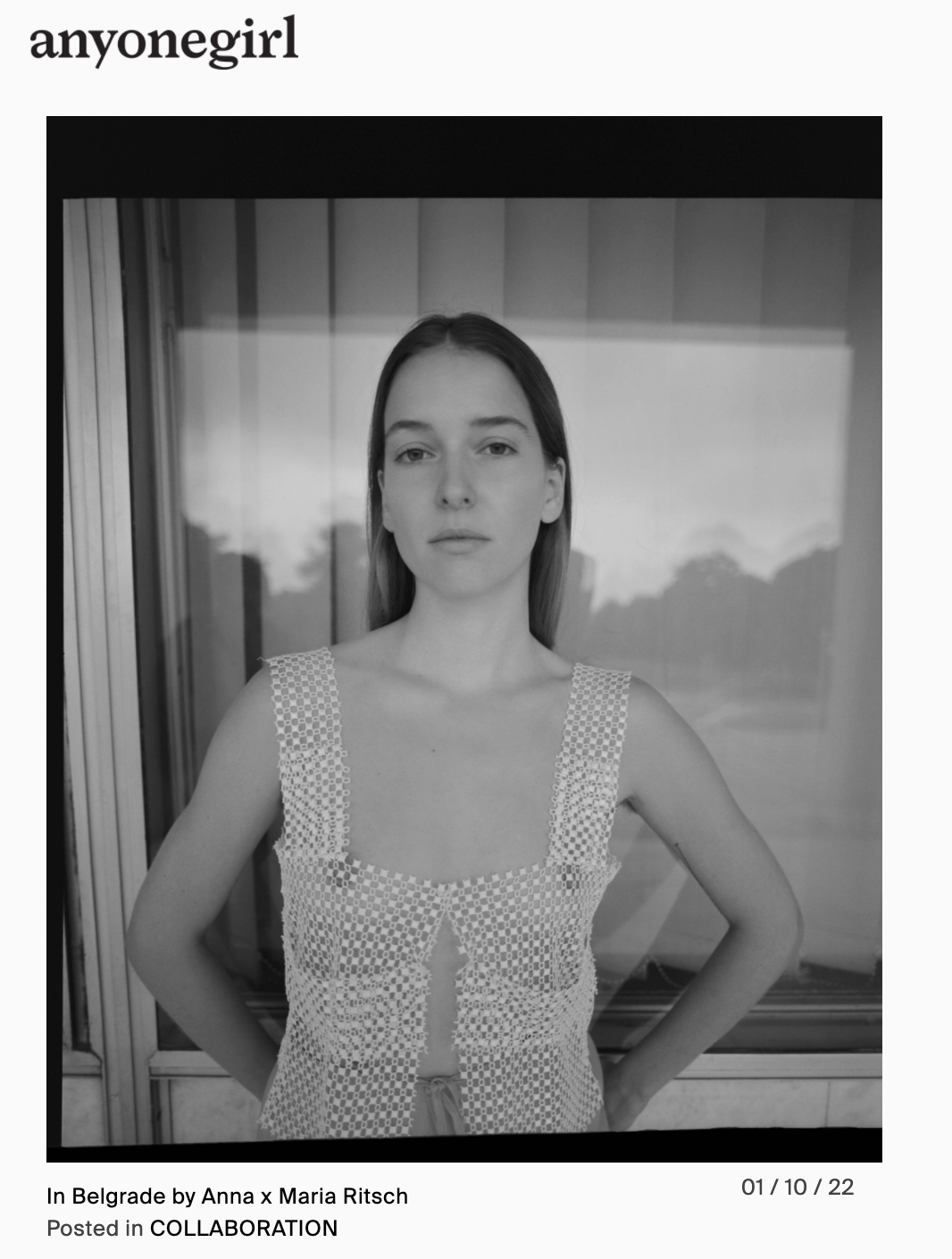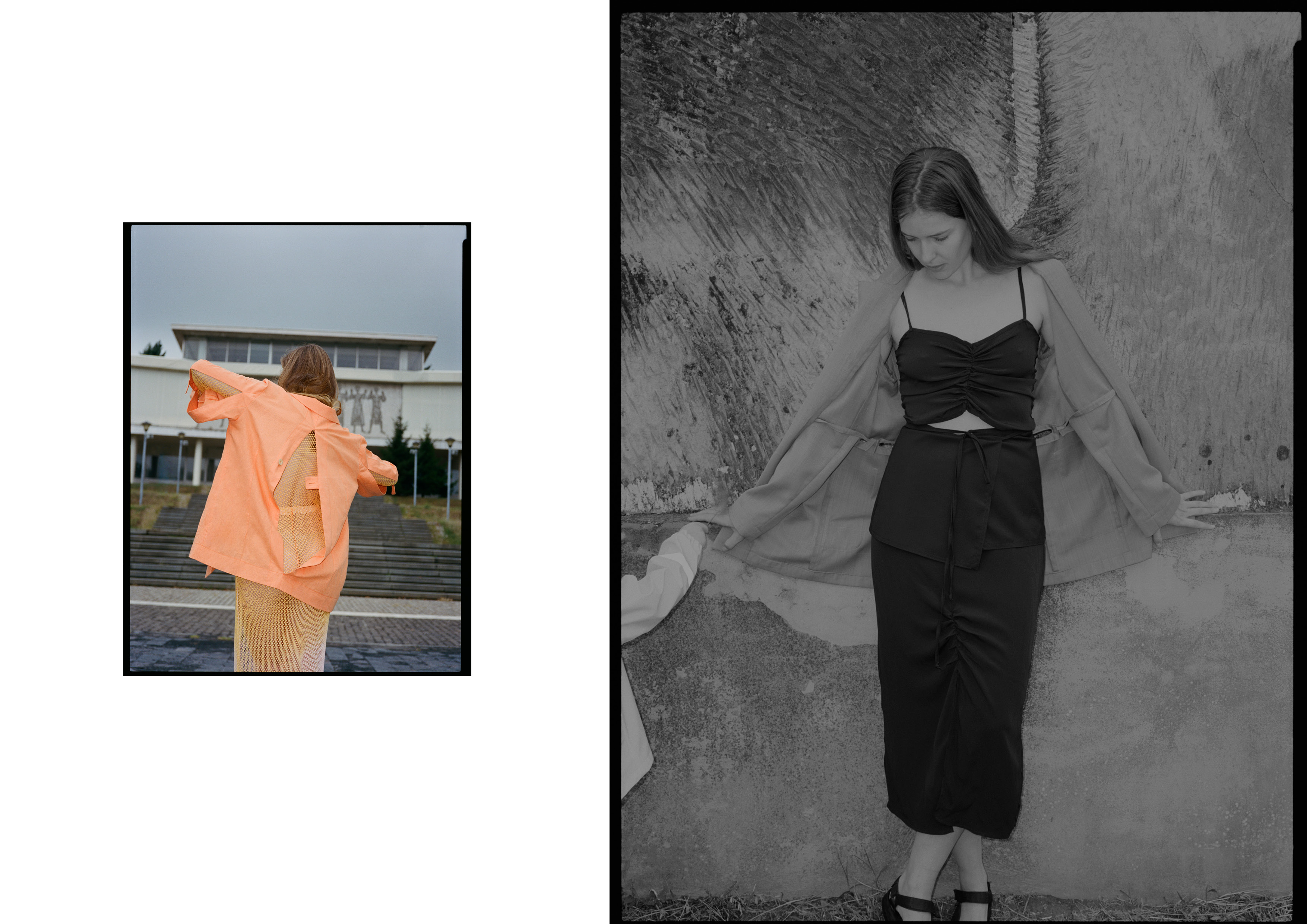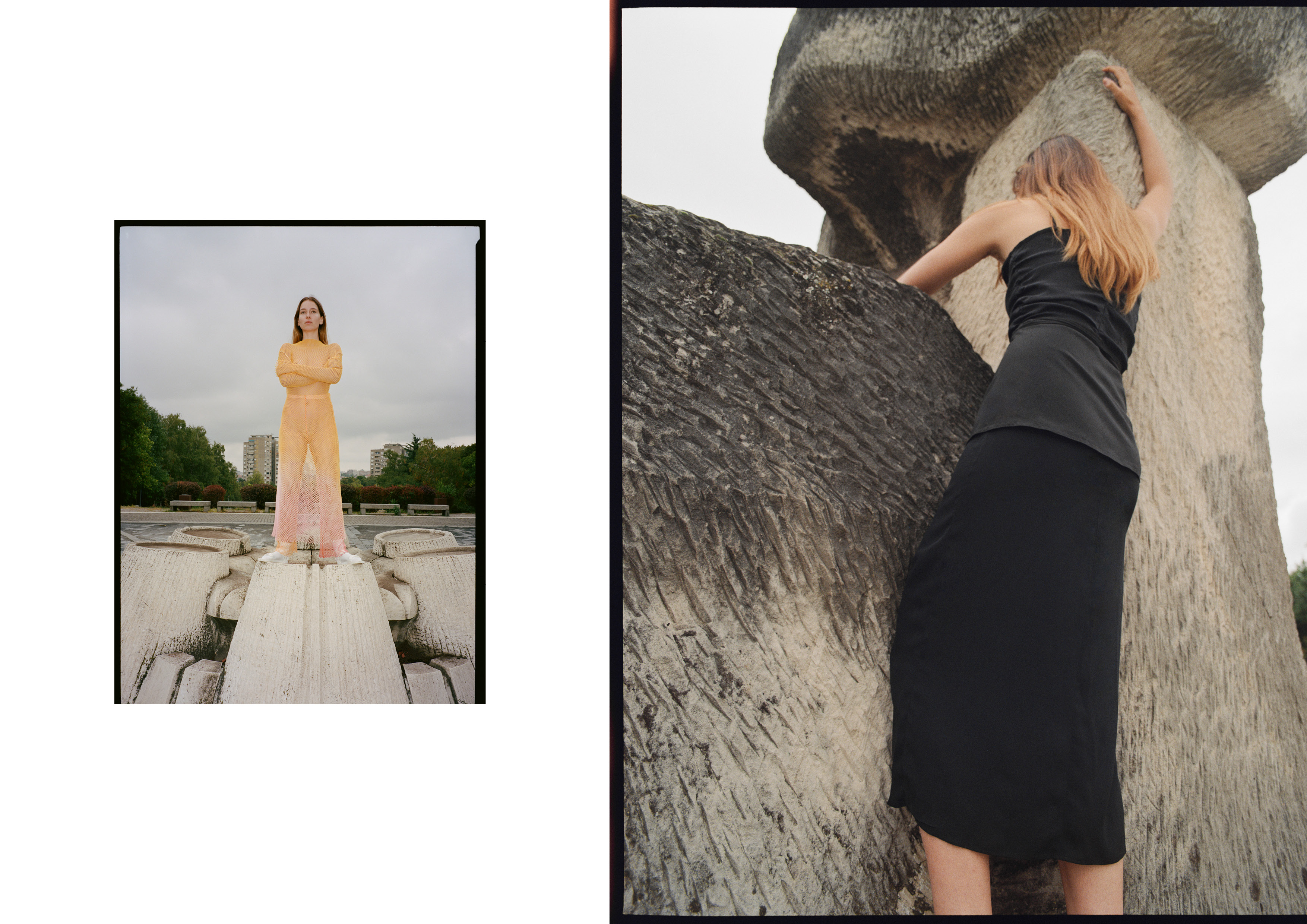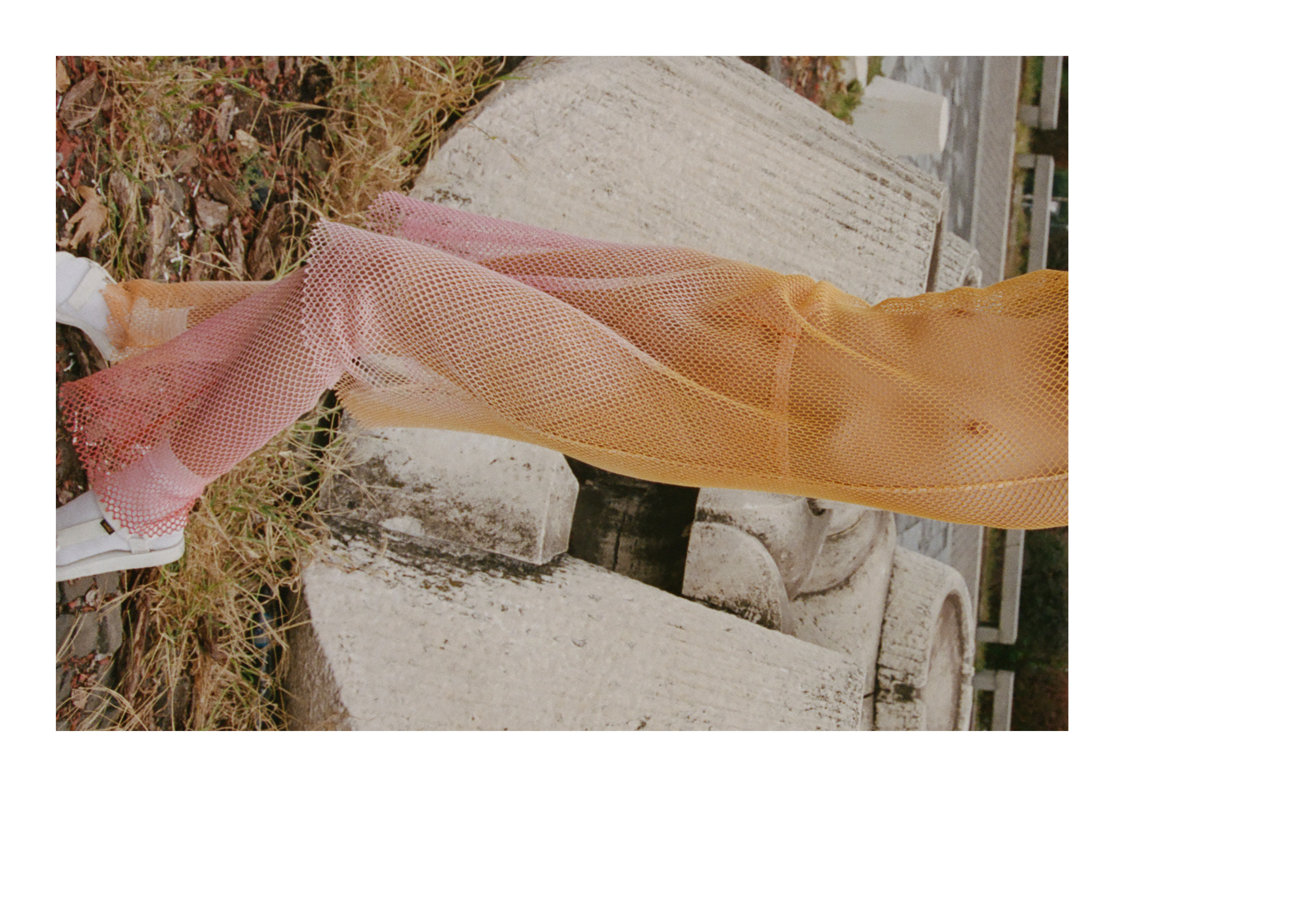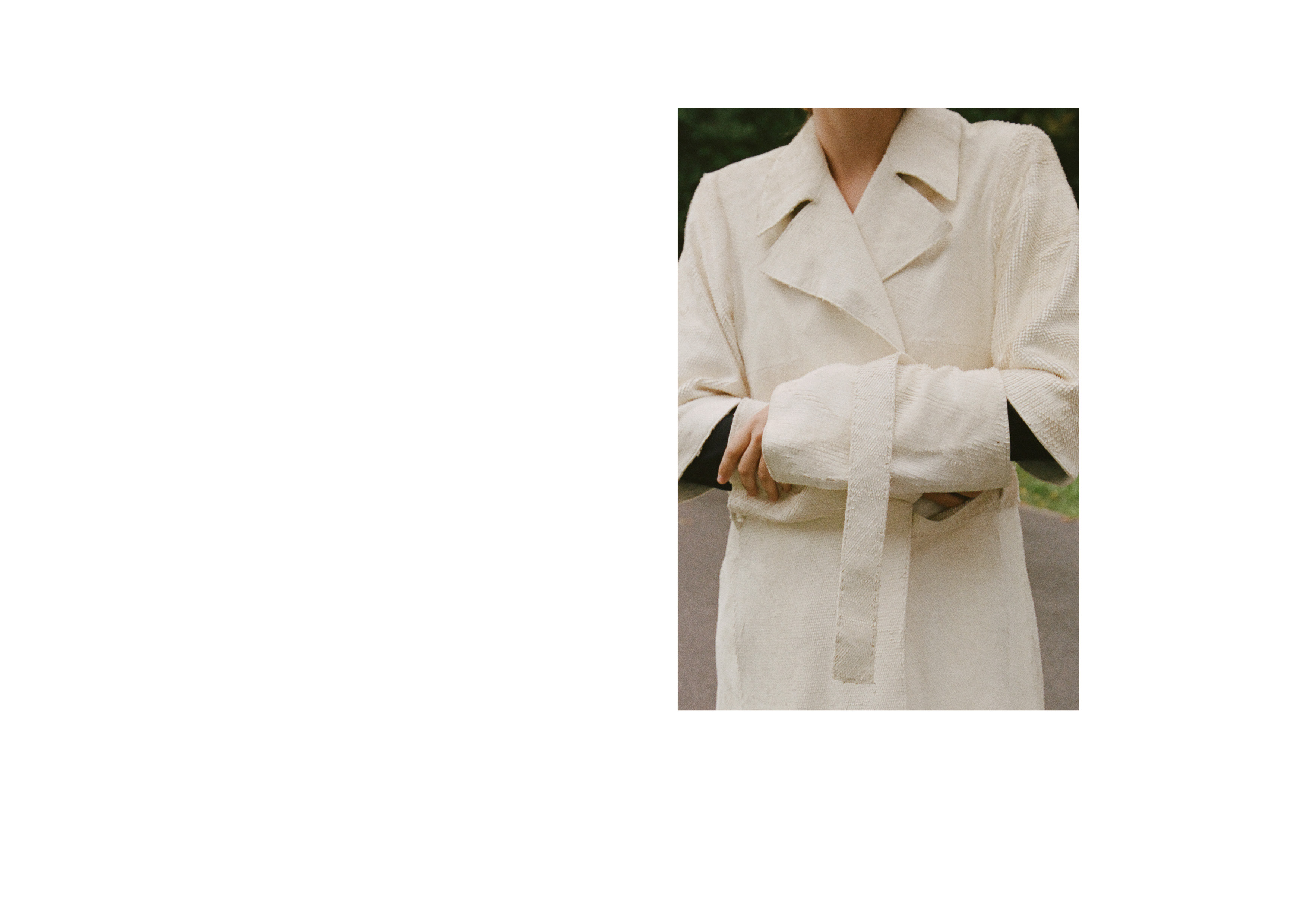‘in Belgrade’
a collaborative dialogue...
with Andrea Lausevic and Designers Jovana Markovic and Tijana Milutinovic
Belgrade, Serbia 2021
Story & Interview feautred on ‘anyonegirl’
In conversation with Anna + Maria (photographers)
How did this shoot come to be and what is the importance of the locations?
The trip to Belgrade was also a research trip for a more personal project on ‘home/borders’, through our grandmother’s experience of growing up in Zemun (New Belgrade) and her lost home when she had to leave it behind during war.
We had never been before and we wanted to explore and connect with this unfamiliar part of our history.
Our grandmother’s dad was a tailor working in the City of Belgrade.
So aside from our personal project we also wanted to see if we could create a fashion portrait story with young designers in Belgrade, connecting to this unknown city through garments, textures and architecture.
We got in touch with Andrea Lausevic (the model in our story) who we know from New York and who is from Belgrade, grew up there and through modeling left as a teenager. She kept visiting Belgrade, never really lived there anymore, but decided this summer to move back for some months with her son, reconnect to her home and work on a personal film project.
We knew we wanted to work with her as the talent and she connected us then with the Designers Jovana Markovic & Tijana Milutinovic, to collaborate on this story. We really admire their work and their design, textures, and fabrics were perfect for this.
All these elements are essential to the story, including Andrea as our talent and her reconnecting to the city, our first time connecting to the city, and the designers living and creating out of this city. We purposefully chose locations that tell history, are monumental, sculptural as the setting for talent & garments.
We tried to emerge ourselves into the energy of this city through a playful and collaborative way.
What are some parallels you can draw between the garments and the architecture?
Some of the parallels that come to mind are, abstraction, form, structure, lines, cut outs, pattern, texture, surfaces and materials. It also has this formal playfulness, classic and elegant but still allowing for something unique, something to break free of. There is also something gestural that we see in both the garments and the architecture we chose.
I love the energy and vibe captured. What was the overall feeling on set, and did the garments initiate any of the decisions around imagery?
It was a very intimate and collaborative energy on set and we relied a lot on Andrea to first introduce and connect us to the surroundings and the locations we were shooting at.
From that on we then decided what garments/ looks we either wanted to contrast, juxtaposition or complement with the specific architecture at the location. Overall the shapes, lines, textures and colors of the garments influenced our decision on how and where to photograph each look.
—
Jovana Markovic (Designer)
What does it mean for you to be a designer in Serbia?
Personally I feel that being a designer in Serbia brings some advantages at least in terms of production. In Serbia I can produce locally as we have few good seamstresses/sewers and good quality productions for much lower pricing compared to other places like Paris, London or New York City. The biggest market for selling my designs nevertheless happens abroad which makes me happy as well, that my designs speak a very international contemporary language. Living in Serbia and having a brand that works internationally makes my life very impactful and provides new opportunities.
Can you tell us about sourcing craftsmen and textile-based studies to produce national dialogues within your work?
It took me some time to find the right fits and highest quality productions in Serbia. It’s very important to me to focus on the best quality and working with people who can realize my visions. I have been in the business quite a while now so I do feel I managed to find the finest natural materials for the construction of each piece, locally here in Serbia.
What elements of Serbian heritage have you explored in this collection?
In this collection I focused more on an abstract vision – playing with a variety of textures and transparent fabrics, with layering different shapes and combining materials that incorporate this vision.
I love how textural your collection and the chosen locations are. Can you expand on how your designs echo the local urban environment?
I think the locations that we used for the photoshoot with Anna and Maria give my designs a new context that I didn’t set intentionally as in my designs I was focusing more on an abstract and experimental level. The chosen locations are very monumental which adds a new very interesting layer and aligns with the shapes and materials I used.
Choosing to work with photographers Anna and Maria, feels like such a perfect fit. How did you initially come across their work?
I so agree. Their aesthetic is very close to mine and I just love the photos that they did.
They are so talented and I came across their work through our mutual friend Andrea who is the talent in this story. I would love to work with them again and hopefully it will happen soon
—
Tijana Milutinovic (Designer)
What does it mean for you to be a designer in Serbia?
Designing for me represents the intimate act of need which I can not clearly define by geographical or national impact. But fashion design in Serbia is really missing essential parts of industrial/market support, so it’s quite often challenging to maintain doing something on your own aside from this dominant/vital market.
Can you tell us about sourcing craftsmen and textile-based studies to produce national dialogues within your work?
My collections are small (often one piece) locally produced in a small studio by few people. This previous collection was mostly made by hand dyed textiles in collaboration with textile designer Jovana Petrović who gave her unique design to the textile from local suppliers. That kind of interweaving acts and dialogues are what inspires me.
What elements of Serbian heritage have you explored in this collection?
In general I’m fascinated by folklore and heritage in a wider sense, so I always try to be close enough to that idea and far enough away, so I can nurture that kind of feeling I love “to belong and to be free”. In the previous collection I didn’t refer to anything specifically, like I did for example in some of my earlier collections where I treated some folklore pieces like “jelek” or “pregača” (a kind of women’s vest and apron-skirt).
I love how textural your collection and the chosen locations are. Can you expand on how your designs echo the local urban environment?
The moment of now is the only thing we have. For me, designing is about the natural feeling of being/creating something somewhere now. I was always in the mood to think about “local” feelings in my work, searching and trying to define the position of my work in an “in and out” context, so I believe that my work reflects the moment as much as I understand it well.
Choosing to work with photographers Anna and Maria, feels like such a perfect fit. How did you initially come across their work?
Like many other good things this came spontaneously:) I saw Anna and Maria’s work by a friend’s recommendation and at this moment I was happy to be involved within work I like very much.
—
Andrea Lausevic (Talent)
What was your initial motivation for moving back to Belgrade?
After completing the gender studies master’s program in NYC, I decided to travel back to Belgrade and conduct research that will concern the most vulnerable group in Serbia–Roma women. A topic that is rarely discussed in public discourse. Over time, this research has turned from a typical qualitative study to a documentary film with a script. It has been an emotional rollercoaster of experience, firstly by dealing with a delicate subject–experiences of marginalised women, but also with my return to my homeland, resurfacing memories and past experiences.
Can you share with us some of the feelings you had in response to the garments? Did you have any pre existing connections to any of the shoot locations? And did this inform the way you moved or felt at all?
It felt great working with Anna and Maria, more of a creative collaboration rather than a typical model-photographer relationship. They consulted me about selecting the potential shooting locations, our choice fell to Yugoslavia museum and Museum of contemporary art for it’s brutalist aesthetic that echoes the atmosphere in which I grew up in Serbia. Wearing Jovana’s clothes is always a pleasure, her designs are simple, yet so flattering to the body. The fresh orange and teal worked well with the exterior, hints of brightness among the dull greys. Tijana’s stuff was very playful, stretchy mesh and cozy cardigans with beautiful gradients that remind me of a summer dawn.
anyonegirl
Designers Jovana Markovic & Tijana Milutinovic
Model Andrea Lausevic
Photographers Anna and Maria Ritsch
a collaborative dialogue...
with Andrea Lausevic and Designers Jovana Markovic and Tijana Milutinovic
Belgrade, Serbia 2021
Story & Interview feautred on ‘anyonegirl’
In conversation with Anna + Maria (photographers)
How did this shoot come to be and what is the importance of the locations?
The trip to Belgrade was also a research trip for a more personal project on ‘home/borders’, through our grandmother’s experience of growing up in Zemun (New Belgrade) and her lost home when she had to leave it behind during war.
We had never been before and we wanted to explore and connect with this unfamiliar part of our history.
Our grandmother’s dad was a tailor working in the City of Belgrade.
So aside from our personal project we also wanted to see if we could create a fashion portrait story with young designers in Belgrade, connecting to this unknown city through garments, textures and architecture.
We got in touch with Andrea Lausevic (the model in our story) who we know from New York and who is from Belgrade, grew up there and through modeling left as a teenager. She kept visiting Belgrade, never really lived there anymore, but decided this summer to move back for some months with her son, reconnect to her home and work on a personal film project.
We knew we wanted to work with her as the talent and she connected us then with the Designers Jovana Markovic & Tijana Milutinovic, to collaborate on this story. We really admire their work and their design, textures, and fabrics were perfect for this.
All these elements are essential to the story, including Andrea as our talent and her reconnecting to the city, our first time connecting to the city, and the designers living and creating out of this city. We purposefully chose locations that tell history, are monumental, sculptural as the setting for talent & garments.
We tried to emerge ourselves into the energy of this city through a playful and collaborative way.
What are some parallels you can draw between the garments and the architecture?
Some of the parallels that come to mind are, abstraction, form, structure, lines, cut outs, pattern, texture, surfaces and materials. It also has this formal playfulness, classic and elegant but still allowing for something unique, something to break free of. There is also something gestural that we see in both the garments and the architecture we chose.
I love the energy and vibe captured. What was the overall feeling on set, and did the garments initiate any of the decisions around imagery?
It was a very intimate and collaborative energy on set and we relied a lot on Andrea to first introduce and connect us to the surroundings and the locations we were shooting at.
From that on we then decided what garments/ looks we either wanted to contrast, juxtaposition or complement with the specific architecture at the location. Overall the shapes, lines, textures and colors of the garments influenced our decision on how and where to photograph each look.
—
Jovana Markovic (Designer)
What does it mean for you to be a designer in Serbia?
Personally I feel that being a designer in Serbia brings some advantages at least in terms of production. In Serbia I can produce locally as we have few good seamstresses/sewers and good quality productions for much lower pricing compared to other places like Paris, London or New York City. The biggest market for selling my designs nevertheless happens abroad which makes me happy as well, that my designs speak a very international contemporary language. Living in Serbia and having a brand that works internationally makes my life very impactful and provides new opportunities.
Can you tell us about sourcing craftsmen and textile-based studies to produce national dialogues within your work?
It took me some time to find the right fits and highest quality productions in Serbia. It’s very important to me to focus on the best quality and working with people who can realize my visions. I have been in the business quite a while now so I do feel I managed to find the finest natural materials for the construction of each piece, locally here in Serbia.
What elements of Serbian heritage have you explored in this collection?
In this collection I focused more on an abstract vision – playing with a variety of textures and transparent fabrics, with layering different shapes and combining materials that incorporate this vision.
I love how textural your collection and the chosen locations are. Can you expand on how your designs echo the local urban environment?
I think the locations that we used for the photoshoot with Anna and Maria give my designs a new context that I didn’t set intentionally as in my designs I was focusing more on an abstract and experimental level. The chosen locations are very monumental which adds a new very interesting layer and aligns with the shapes and materials I used.
Choosing to work with photographers Anna and Maria, feels like such a perfect fit. How did you initially come across their work?
I so agree. Their aesthetic is very close to mine and I just love the photos that they did.
They are so talented and I came across their work through our mutual friend Andrea who is the talent in this story. I would love to work with them again and hopefully it will happen soon
—
Tijana Milutinovic (Designer)
What does it mean for you to be a designer in Serbia?
Designing for me represents the intimate act of need which I can not clearly define by geographical or national impact. But fashion design in Serbia is really missing essential parts of industrial/market support, so it’s quite often challenging to maintain doing something on your own aside from this dominant/vital market.
Can you tell us about sourcing craftsmen and textile-based studies to produce national dialogues within your work?
My collections are small (often one piece) locally produced in a small studio by few people. This previous collection was mostly made by hand dyed textiles in collaboration with textile designer Jovana Petrović who gave her unique design to the textile from local suppliers. That kind of interweaving acts and dialogues are what inspires me.
What elements of Serbian heritage have you explored in this collection?
In general I’m fascinated by folklore and heritage in a wider sense, so I always try to be close enough to that idea and far enough away, so I can nurture that kind of feeling I love “to belong and to be free”. In the previous collection I didn’t refer to anything specifically, like I did for example in some of my earlier collections where I treated some folklore pieces like “jelek” or “pregača” (a kind of women’s vest and apron-skirt).
I love how textural your collection and the chosen locations are. Can you expand on how your designs echo the local urban environment?
The moment of now is the only thing we have. For me, designing is about the natural feeling of being/creating something somewhere now. I was always in the mood to think about “local” feelings in my work, searching and trying to define the position of my work in an “in and out” context, so I believe that my work reflects the moment as much as I understand it well.
Choosing to work with photographers Anna and Maria, feels like such a perfect fit. How did you initially come across their work?
Like many other good things this came spontaneously:) I saw Anna and Maria’s work by a friend’s recommendation and at this moment I was happy to be involved within work I like very much.
—
Andrea Lausevic (Talent)
What was your initial motivation for moving back to Belgrade?
After completing the gender studies master’s program in NYC, I decided to travel back to Belgrade and conduct research that will concern the most vulnerable group in Serbia–Roma women. A topic that is rarely discussed in public discourse. Over time, this research has turned from a typical qualitative study to a documentary film with a script. It has been an emotional rollercoaster of experience, firstly by dealing with a delicate subject–experiences of marginalised women, but also with my return to my homeland, resurfacing memories and past experiences.
Can you share with us some of the feelings you had in response to the garments? Did you have any pre existing connections to any of the shoot locations? And did this inform the way you moved or felt at all?
It felt great working with Anna and Maria, more of a creative collaboration rather than a typical model-photographer relationship. They consulted me about selecting the potential shooting locations, our choice fell to Yugoslavia museum and Museum of contemporary art for it’s brutalist aesthetic that echoes the atmosphere in which I grew up in Serbia. Wearing Jovana’s clothes is always a pleasure, her designs are simple, yet so flattering to the body. The fresh orange and teal worked well with the exterior, hints of brightness among the dull greys. Tijana’s stuff was very playful, stretchy mesh and cozy cardigans with beautiful gradients that remind me of a summer dawn.
anyonegirl
Designers Jovana Markovic & Tijana Milutinovic
Model Andrea Lausevic
Photographers Anna and Maria Ritsch
